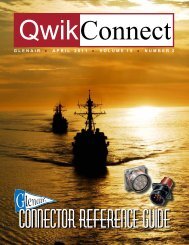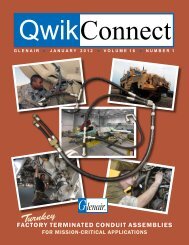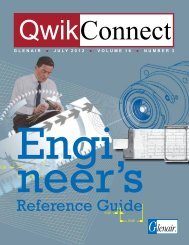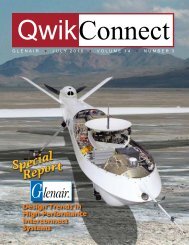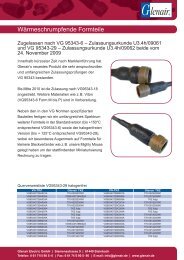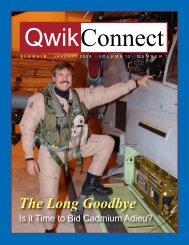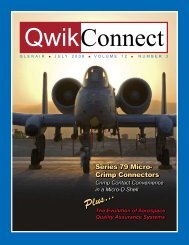April 2010 - Glenair, Inc.
April 2010 - Glenair, Inc.
April 2010 - Glenair, Inc.
You also want an ePaper? Increase the reach of your titles
YUMPU automatically turns print PDFs into web optimized ePapers that Google loves.
around these openings are provided in the project<br />
peculiar documentation in accordance with NAVSEA<br />
preservation Process Instruction 63101-005 8 .<br />
Composite■Electrical■Enclosures<br />
Brass electrical enclosures have been widely<br />
used on the weather decks of surface ships ever<br />
since their original design implementation just after<br />
Composite<br />
Electrical■Enclosure■<br />
and■Conduit■<br />
Terminations<br />
World War II. These legacy topside components do<br />
not hold up to the corrosive marine environment and<br />
typically degrade such that they need replacement<br />
about every 5 years. There are chronic internal<br />
and external corrosion issues that result in ship’s<br />
QwikConnect n <strong>April</strong> <strong>2010</strong><br />
force dedicating an inordinate amount of resources<br />
replacing and repairing equipment that has faltered<br />
or failed.<br />
The composite program objectives were to<br />
eliminate chronic internal and external corrosion<br />
issues, to develop technologies that are corrosion<br />
free by eliminating galvanic couples internally and<br />
to the surrounding mounting areas, and, to develop<br />
a product which is fire hardened providing extended<br />
service life from current antiquated designs.<br />
Shipboard inspection and interviews with maintenance<br />
personnel led to desired attributes were incorporated<br />
into the NAVSEA design That systems approach was<br />
taken for the redesign of the electrical enclosures<br />
which resulted in a corrosion free composite<br />
enclosure which features and 316L alloy standoff<br />
mounting system providing trouble free service.<br />
Also, it is a true watertight design and the<br />
composite material also reduces the thermal<br />
cycling problematic of the steel, brass, and titanium<br />
boxes. Also, spring loaded lid design enhances<br />
the corrosion and water resistance and eliminates<br />
the ‘lid on a leash’. This technology has provided<br />
greater system reliability and significantly reduced<br />
maintenance work load. Further refinements resulted<br />
from two years of OPEVALs on CVN-71, DDG-52,<br />
LSD 47 and CG-72 led to the development of a<br />
standard NAVSEA Drawing 9 for composite boxes in<br />
order to institutionalize these components.<br />
Composite■Conduit■and<br />
Box■Termination■End■Fittings<br />
The most recent application of composites<br />
has been in their use for electrical conduit and the<br />
termination fittings that attach the conduit to the<br />
already developed electrical boxes. The problem<br />
of conduit is most evident in the well deck areas of<br />
amphibious ships, where the salt spray combined<br />
with the heated exhaust of Landing Craft Air<br />
Cushioned (LCAC) units destroys the current system<br />
in a matter of months. A commercially available<br />
ribbed conduit made from Poly Ether Ether Keytone<br />
(PEEK) was identified to solve this problem. The<br />
use of composites for termination end fittings was<br />
more problematic due to the need to ensure that<br />
appropriate grounding was maintained between the<br />
conduit, the enclosure and the ship’s hull.<br />
11



